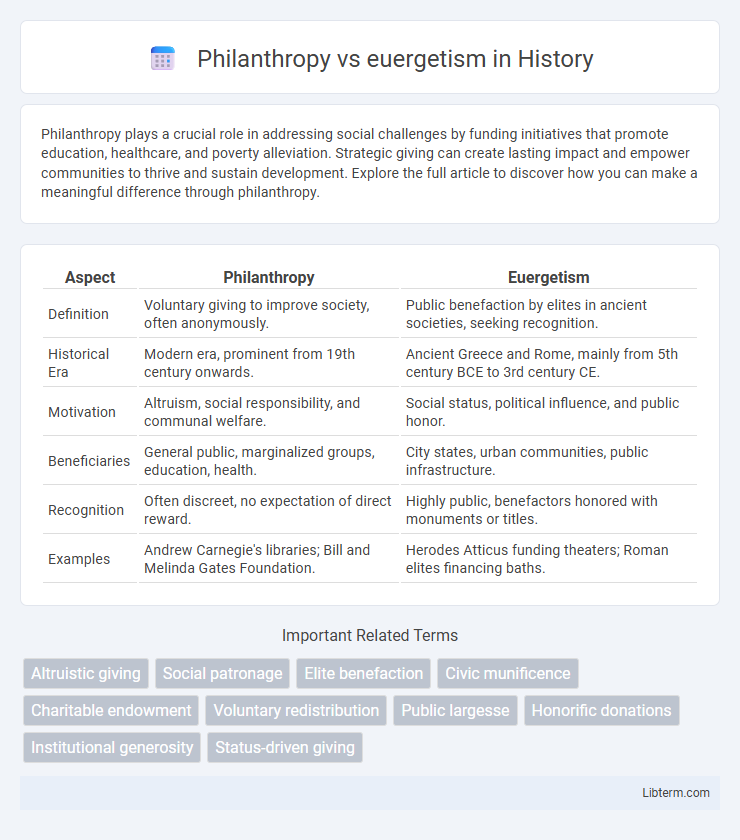Philanthropy plays a crucial role in addressing social challenges by funding initiatives that promote education, healthcare, and poverty alleviation. Strategic giving can create lasting impact and empower communities to thrive and sustain development. Explore the full article to discover how you can make a meaningful difference through philanthropy.
Table of Comparison
| Aspect | Philanthropy | Euergetism |
|---|---|---|
| Definition | Voluntary giving to improve society, often anonymously. | Public benefaction by elites in ancient societies, seeking recognition. |
| Historical Era | Modern era, prominent from 19th century onwards. | Ancient Greece and Rome, mainly from 5th century BCE to 3rd century CE. |
| Motivation | Altruism, social responsibility, and communal welfare. | Social status, political influence, and public honor. |
| Beneficiaries | General public, marginalized groups, education, health. | City states, urban communities, public infrastructure. |
| Recognition | Often discreet, no expectation of direct reward. | Highly public, benefactors honored with monuments or titles. |
| Examples | Andrew Carnegie's libraries; Bill and Melinda Gates Foundation. | Herodes Atticus funding theaters; Roman elites financing baths. |
Understanding Philanthropy: Modern Perspectives
Philanthropy in modern perspectives emphasizes strategic giving that seeks measurable social impact, often through organized foundations and non-profit partnerships. It contrasts with euergetism, an ancient practice of elite benefactors providing public goods directly to communities as a form of social obligation and status. Contemporary philanthropy prioritizes long-term systemic change, data-driven initiatives, and transparency to address complex societal challenges effectively.
Defining Euergetism: Historical Context and Meaning
Euergetism, derived from the Greek word "euergetes" meaning "benefactor," refers to the practice of wealthy individuals or elites distributing wealth or gifts to the community in ancient societies, particularly in Greco-Roman contexts. Unlike modern philanthropy, which often emphasizes altruistic motives and institutional frameworks, euergetism was closely tied to social status, political power, and reciprocal relationships between benefactors and beneficiaries. Historical records highlight that euergetic acts such as funding public buildings, festivals, or infrastructure served both communal benefits and reinforced the benefactor's prestige and authority.
Origins and Evolution: Philanthropy vs. Euergetism
Philanthropy originated in ancient Greek society as voluntary acts of public generosity aimed at promoting the welfare of the community, while euergetism emerged as a formalized system where wealthy elites funded public works and services to gain social prestige and political influence. Over time, philanthropy evolved into a broader, more institutionalized practice involving private foundations and non-profits dedicated to diverse social causes, whereas euergetism remained closely tied to elite self-interest and civic obligation within hierarchical societies. The transformation of philanthropy reflects shifts towards democratization and global humanitarianism, contrasting with the traditional, reciprocal nature of euergetism as a social contract between rulers and citizens.
Key Motivations Behind Giving
Philanthropy is driven by altruistic motivations aimed at addressing social causes and creating long-term impact, often through organized charitable efforts and grants. Euergetism, rooted in ancient practices, focuses on public benefaction to gain social prestige and political influence by funding civic projects or monuments. Both forms of giving reflect distinct underlying incentives: philanthropy emphasizes broad social welfare, while euergetism is primarily motivated by personal honor and community recognition.
Social Impact: Comparing Outcomes of Both Practices
Philanthropy and euergetism both aim to improve social welfare but differ in scope and impact, with philanthropy often addressing root causes through organized funding and strategic initiatives, resulting in long-term systemic change. Euergetism, historically characterized by wealthy individuals directly funding public goods like infrastructure or festivals, tends to produce immediate, localized benefits that reinforce social hierarchy. Measuring social impact reveals philanthropy's potential for sustainable community development, while euergetism usually enhances civic pride and social cohesion within specific regions.
Public Recognition and Social Status
Philanthropy often involves anonymous or low-key donations, emphasizing the altruistic intent over public recognition, whereas euergetism explicitly seeks public acknowledgment and enhances social status through visible benefactions. In ancient societies, euergetism served as a means for elites to gain political power and civic honor by funding public projects, monuments, or festivals. Modern philanthropy may still confer social prestige but typically prioritizes impact and privacy, contrasting with the overt social signaling characteristic of euergetism.
Role of Institutions: Then and Now
Institutions historically shaped euergetism by formalizing public benefactions from wealthy individuals, embedding social obligations within civic frameworks, such as ancient Greek city-states where magistrates distributed wealth for public projects. In contrast, modern philanthropy operates through structured nonprofit organizations and foundations, leveraging institutional governance to address systemic social issues on a global scale. The evolution from personal honor-bound contributions to strategic, institutionalized philanthropy reflects changes in societal complexity and accountability mechanisms.
Cultural and Moral Foundations
Philanthropy and euergetism both stem from cultural and moral foundations that emphasize communal responsibility and social harmony. Philanthropy is rooted in altruism and modern ethical frameworks promoting voluntary giving to address social issues, while euergetism originates from ancient civic duty practices where elites provided public goods to gain honor and reinforce social order. These traditions reflect differing motivations: philanthropy prioritizes ethical generosity and social justice, whereas euergetism aligns with reciprocal obligations and status reinforcement in historical communities.
Challenges and Criticisms of Each Approach
Philanthropy often faces criticism for perpetuating power imbalances and failing to address systemic issues, as it can prioritize donor interests over community needs. Euergetism, while historically significant in promoting public goods through elite benefactions, is challenged by its reliance on uneven wealth distribution and potential for reinforcing social hierarchies. Both approaches struggle with sustainability and accountability, raising concerns about their long-term impact on equitable social development.
Philanthropy and Euergetism in Today’s Society
Philanthropy in today's society centers on voluntary, strategic donations aimed at addressing systemic social issues through organizations like nonprofits and foundations, leveraging data-driven impact assessment. Euergetism, rooted in ancient traditions of wealth distribution to communities via public works or events, persists in modern forms through patronage and sponsorship that bolster cultural and civic projects. While philanthropy emphasizes long-term societal change and accountability, euergetism often sustains community identity and social cohesion by fostering direct relationships between benefactors and beneficiaries.
Philanthropy Infographic

 libterm.com
libterm.com